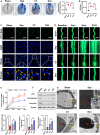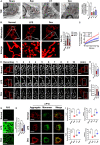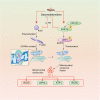Protective Effects of Dexmedetomidine on the Vascular Endothelial Barrier Function by Inhibiting Mitochondrial Fission via ER/Mitochondria Contact
- PMID: 33777946
- PMCID: PMC7991806
- DOI: 10.3389/fcell.2021.636327
Protective Effects of Dexmedetomidine on the Vascular Endothelial Barrier Function by Inhibiting Mitochondrial Fission via ER/Mitochondria Contact
Abstract
The damage of vascular endothelial barrier function induced by sepsis is critical in causing multiple organ dysfunctions. Previous studies showed that dexmedetomidine (Dex) played a vital role in protecting organ functions. However, whether Dex participates in protecting vascular leakage of sepsis and the associated underlying mechanism remains unknown yet. We used cecal ligation and puncture induced septic rats and lipopolysaccharide stimulated vascular endothelial cells (VECs) to establish models in vivo and in vitro, then the protective effects of Dex on the vascular endothelial barrier function of sepsis were observed, meanwhile, related mechanisms on regulating mitochondrial fission were further studied. The results showed that Dex could significantly reduce the permeability of pulmonary veins and mesenteric vessels, increase the expression of intercellular junction proteins, enhance the transendothelial electrical resistance and decrease the transmittance of VECs, accordingly protected organ functions and prolonged survival time in septic rats. Besides, the mitochondria of VECs were excessive division after sepsis, while Dex could significantly inhibit the mitochondrial fission and protect mitochondrial function by restoring mitochondrial morphology of VECs. Furthermore, the results showed that ER-MITO contact sites of VECs were notably increased after sepsis. Nevertheless, Dex reduced ER-MITO contact sites by regulating the polymerization of actin via α2 receptors. The results also found that Dex could induce the phosphorylation of the dynamin-related protein 1 through down-regulating extracellular signal-regulated kinase1/2, thus playing a role in the regulation of mitochondrial division. In conclusion, Dex has a protective effect on the vascular endothelial barrier function of septic rats. The mechanism is mainly related to the regulation of Drp1 phosphorylation of VECs, inhibition of mitochondrial division by ER-MITO contacts, and protection of mitochondrial function.
Keywords: Drp1; ER-MITO contact; dexmedetomidine; sepsis; vascular endothelial barrier function.
Copyright © 2021 She, Zhu, Deng, Kuang, Fang, Zhang, Duan, Ye, Zhang, Liu, Hu and Li.
Conflict of interest statement
The authors declare that the research was conducted in the absence of any commercial or financial relationships that could be construed as a potential conflict of interest.
Figures







Similar articles
-
Protective Effects of Dexmedetomidine on Sepsis-Induced Vascular Leakage by Alleviating Ferroptosis via Regulating Metabolic Reprogramming.J Inflamm Res. 2021 Dec 10;14:6765-6782. doi: 10.2147/JIR.S340420. eCollection 2021. J Inflamm Res. 2021. PMID: 34916824 Free PMC article.
-
Dexmedetomidine maintains blood-brain barrier integrity by inhibiting Drp1-related endothelial mitochondrial dysfunction in ischemic stroke.Acta Biochim Biophys Sin (Shanghai). 2021 Aug 31;53(9):1177-1188. doi: 10.1093/abbs/gmab092. Acta Biochim Biophys Sin (Shanghai). 2021. PMID: 34244711
-
Role of connexin 43 in vascular hyperpermeability and relationship to Rock1-MLC20 pathway in septic rats.Am J Physiol Lung Cell Mol Physiol. 2015 Dec 1;309(11):L1323-32. doi: 10.1152/ajplung.00016.2015. Epub 2015 Sep 4. Am J Physiol Lung Cell Mol Physiol. 2015. PMID: 26342084
-
Dexmedetomidine effects in different experimental sepsis in vivo models.Eur J Pharmacol. 2019 Aug 5;856:172401. doi: 10.1016/j.ejphar.2019.05.030. Epub 2019 May 17. Eur J Pharmacol. 2019. PMID: 31108055 Review.
-
Dexmedetomidine May Produce Extra Protective Effects on Sepsis-induced Diaphragm Injury.Chin Med J (Engl). 2015 May 20;128(10):1407-11. doi: 10.4103/0366-6999.156808. Chin Med J (Engl). 2015. PMID: 25963365 Free PMC article. Review.
Cited by
-
The perspective of modern transplant science - transplant arteriosclerosis: inspiration derived from mitochondria associated endoplasmic reticulum membrane dysfunction in arterial diseases.Int J Surg. 2025 May 1;111(5):3430-3440. doi: 10.1097/JS9.0000000000002362. Int J Surg. 2025. PMID: 40146783 Free PMC article. Review.
-
Unfractionated Heparin Enhances Sepsis Prognosis Through Inhibiting Drp1-Mediated Mitochondrial Quality Imbalance.Adv Sci (Weinh). 2024 Dec;11(46):e2407705. doi: 10.1002/advs.202407705. Epub 2024 Oct 24. Adv Sci (Weinh). 2024. PMID: 39447130 Free PMC article.
-
Vascular endothelial cell injury: causes, molecular mechanisms, and treatments.MedComm (2020). 2025 Jan 16;6(2):e70057. doi: 10.1002/mco2.70057. eCollection 2025 Feb. MedComm (2020). 2025. PMID: 39931738 Free PMC article. Review.
-
The protective effect of pericytes on vascular permeability after hemorrhagic shock and their relationship with Cx43.Front Physiol. 2022 Oct 3;13:948541. doi: 10.3389/fphys.2022.948541. eCollection 2022. Front Physiol. 2022. PMID: 36262250 Free PMC article.
-
Effects of Malate Ringer's solution on myocardial injury in sepsis and enforcement effects of TPP@PAMAM-MR.J Transl Med. 2022 Dec 13;20(1):591. doi: 10.1186/s12967-022-03811-y. J Transl Med. 2022. PMID: 36514103 Free PMC article.
References
LinkOut - more resources
Full Text Sources
Other Literature Sources
Research Materials
Miscellaneous

